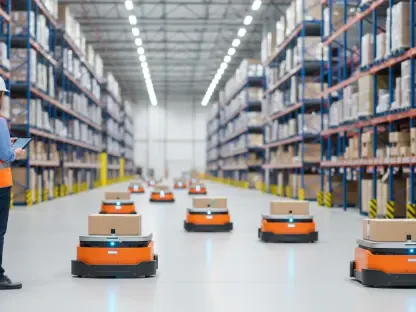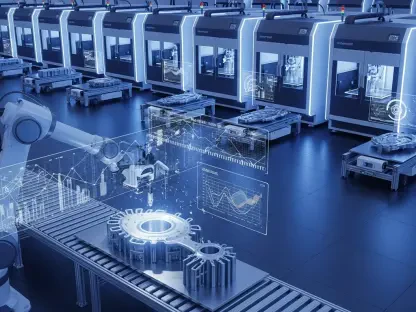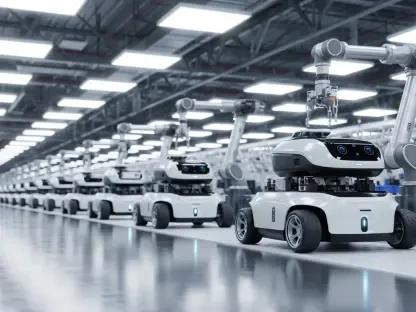In an era where global trade networks are more intricate than ever, supply chains and distribution systems face unprecedented challenges that threaten efficiency and profitability, pushing industries to seek innovative solutions. Manufacturers and logistics providers are often bogged down by outdated frameworks that struggle to keep pace with rising consumer expectations, geopolitical disruptions, and volatile market demands. Delays, spiraling costs, and missed delivery windows have become all too common, exposing vulnerabilities in traditional setups. Enter Artificial Intelligence (AI), a transformative force poised to redefine how goods move from production to end users. By harnessing data-driven insights and automation, AI offers a lifeline to an industry desperate for agility and transparency. This article delves into the myriad ways AI can overhaul supply chain and distribution operations, addressing long-standing inefficiencies and building a foundation for resilience in a rapidly evolving landscape.
Navigating the Pitfalls of Conventional Logistics
The backbone of many manufacturing and distribution networks still rests on a fragmented mix of legacy systems, such as Enterprise Resource Planning (ERP) software and Warehouse Management Systems (WMS), often supplemented by labor-intensive manual processes. This disjointed structure fosters data silos, where critical information remains trapped within specific departments or tools, delaying communication and hampering swift responses. As a result, decision-making becomes reactive, addressing problems only after they surface rather than preventing them. The reliance on Just-In-Time (JIT) methodologies, while cost-effective under ideal conditions, amplifies risks when disruptions occur, leading to production halts or customer dissatisfaction. Without a clear, unified view of operations, companies struggle to anticipate bottlenecks or mitigate the cascading effects of a single delay, underscoring the urgent need for a more integrated approach to logistics management.
Compounding these systemic issues is the sheer opacity that pervades traditional supply chains, making it nearly impossible to track goods or predict issues across multiple touchpoints. Suppliers, third-party logistics providers, and customers often operate on separate platforms, generating vast amounts of disparate data that remain unconnected. This lack of transparency not only slows down problem-solving but also erodes trust among stakeholders when deadlines are missed or costs overrun. Even minor hiccups, such as a delayed shipment due to unforeseen weather events, can spiral into significant financial losses or reputational damage. The inefficiencies baked into these conventional models reveal a critical gap that technology must bridge, pushing the industry toward solutions that can unify operations and provide real-time visibility to stay competitive in a demanding global market.
Laying the Groundwork with Unified Data Systems
A pivotal step toward modernizing supply chains lies in consolidating fragmented data into a centralized repository, often referred to as a data lake or data lakehouse, which serves as the bedrock for AI-driven transformation. This approach pulls together diverse streams of information, from internal metrics like inventory levels and production schedules to external variables such as shipping statuses, supplier timelines, and environmental factors like port congestion. By creating a single source of truth, businesses can eliminate the blind spots that plague traditional setups, enabling a holistic view of their operations. Such unification is essential for ensuring that data is not only accessible but also contextualized and secure, setting the stage for advanced tools to extract meaningful insights that drive smarter logistics strategies.
However, the challenge of managing this consolidated data cannot be understated, as the volume and complexity often overwhelm conventional analysis methods. Raw numbers from Industrial Internet of Things (IIoT) sensors, sales forecasts, and real-time updates can create a deluge that human teams struggle to process effectively. This is where AI becomes indispensable, stepping in to sift through massive datasets and identify patterns or anomalies that would otherwise go unnoticed. The transition to a unified data architecture empowers companies to move beyond mere data collection, turning information into a strategic asset. With the right infrastructure in place, AI can deliver actionable recommendations, helping firms anticipate demand shifts or supply hiccups before they disrupt the flow of goods across the network.
Harnessing AI for Predictive and Prescriptive Insights
AI’s ability to enhance supply chain operations begins with predictive analytics, a powerful tool that leverages machine learning and historical data to forecast critical variables with remarkable accuracy. This technology can predict customer demand across countless stock-keeping units (SKUs), estimate inventory requirements to avoid both shortages and overstocking, and even calculate supplier lead times based on past performance. By identifying potential disruptions through anomaly detection, such as unexpected delays or equipment failures, predictive models enable companies to prepare for challenges rather than merely react to them. This forward-looking approach marks a significant departure from the guesswork of traditional planning, offering a data-driven lens through which businesses can optimize their resources.
Taking this a step further, prescriptive analytics builds on these forecasts by providing specific, actionable recommendations tailored to unique operational needs. For instance, AI can suggest the most cost-effective allocation of orders among suppliers or dynamically adjust delivery routes in response to real-time traffic or weather data. It can also assist in replanning production schedules when delays arise or optimize labor shifts to match predicted workflow demands. This level of guidance transforms raw predictions into strategic decisions, empowering managers to minimize risks while maximizing efficiency. By integrating predictive and prescriptive capabilities, AI equips supply chains with the intelligence to not only foresee issues but also address them proactively, ensuring smoother operations in an unpredictable environment.
Pioneering Autonomy with Agentic AI Systems
At the forefront of AI’s evolution in logistics is the development of agentic systems, which transcend traditional analytics by offering real-time monitoring and adaptive decision-making without constant human oversight. These advanced tools continuously track operations, issue alerts for emerging issues, and adjust strategies on the fly based on incoming data and learned feedback. For example, an agentic system might autonomously reroute shipments to avoid delays, redistribute stock across warehouses to balance inventory, or even place orders with suppliers when thresholds are met. This shift toward automation represents a future where supply chains operate with minimal intervention, streamlining processes from raw material procurement to final delivery.
The potential of agentic AI extends beyond isolated tasks, aiming for seamless integration across upstream and downstream processes to create a truly cohesive network. By simulating “what-if” scenarios, these systems can test contingency plans and refine responses to hypothetical disruptions, ensuring preparedness for any eventuality. While the transition to such autonomy requires robust data integration and organizational trust in automated decisions, the payoff is a supply chain that adapts instantly to change, reducing costs and enhancing reliability. As agentic AI matures, it promises to redefine logistics management, turning once-static systems into dynamic ecosystems capable of self-optimization in the face of global complexities.
Addressing the Hurdles of AI Implementation
Implementing AI in supply chain and distribution is far from a straightforward endeavor, as companies must navigate a range of technical and organizational barriers to achieve meaningful results. A key decision lies in selecting the right solution—whether opting for off-the-shelf platforms suited for standard challenges, customized tools for niche requirements, or fully bespoke systems for intricate workflows. Each choice carries trade-offs in terms of cost, scalability, and deployment time, necessitating a thorough assessment of operational needs. Beyond technology, success hinges on the quality of underlying data, which must be clean, consistent, and comprehensive to fuel accurate AI outputs. Without this foundation, even the most sophisticated tools risk delivering flawed insights.
Equally critical is the cultural shift required within organizations to embrace AI-driven change, as resistance to new processes can derail even well-planned initiatives. Employees accustomed to manual methods or siloed systems may view automation with skepticism, highlighting the need for training and change management to foster acceptance. A phased implementation strategy often proves effective, starting with small, focused projects that target specific pain points before scaling to broader applications. This gradual approach allows firms to refine their processes, build confidence in AI capabilities, and ultimately achieve millisecond-fast decisions that optimize for cost, efficiency, and resilience. By addressing both technological and human factors, companies can unlock the full potential of AI in transforming logistics.
Shaping a Resilient Future for Logistics
Looking back, the journey of integrating AI into supply chain and distribution tackled deep-rooted inefficiencies that once seemed insurmountable, from fragmented data to reactive planning. The adoption of unified data architectures provided the clarity needed to power predictive and prescriptive analytics, while agentic systems pushed the boundaries of automation. Overcoming implementation challenges through strategic planning and cultural adaptation proved essential in turning technological promise into tangible outcomes. Reflecting on this evolution, it’s evident that AI redefined how manufacturers and logistics providers navigated global complexities, setting a new standard for operational excellence.
Moving forward, the focus should shift to continuous innovation and scalability, ensuring that AI solutions evolve alongside emerging challenges. Companies are encouraged to invest in robust data governance to sustain the accuracy of AI insights, while fostering partnerships across the supply chain to enhance visibility and collaboration. Exploring hybrid models that blend human expertise with automated decision-making could further balance efficiency with adaptability. As the landscape continues to shift, staying ahead will require a commitment to experimentation and learning, ensuring that supply chains remain agile and prepared for whatever lies on the horizon.









